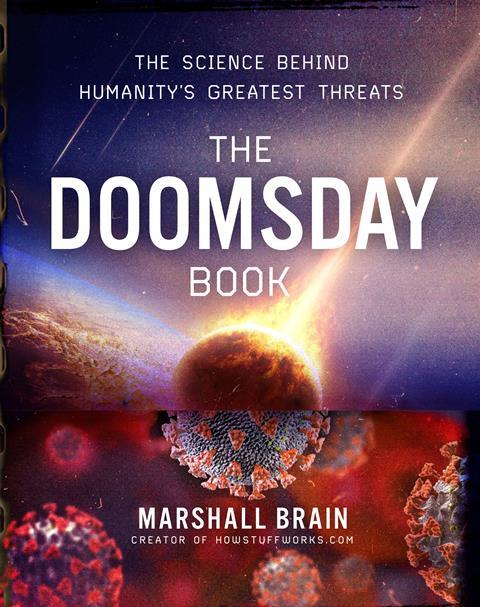Marshall Brain
Sterling Publishing
2020 | 256pp | £25
ISBN 9781454939962
Buy this book on Amazon.co.uk
Buy this book on Bookshop.org

If you’re anything like me, then you spent a good deal of 2020 thinking about the end of the world. At times, it was hard to decide what might be the most likely thing to finish us off – wildfires, climate change, civil unrest and of course a global pandemic all threw their hats into the ring at one point or another, along with countless other little (and large) catastrophes around the world. But what might any of these doomsday scenarios actually look like if they were to play out to their apocalyptic conclusions? And what other dangers are out there lurking out of sight?
Marshall Brain’s The Doomsday Book sets out to answer some of these questions and does so brilliantly. The book is divided into a series of short chapters, each of which tackles a possible doomsday scenario, a term here used to mean any event with the potential to cause widespread catastrophe in the form of death, destruction and/or economic effects. For each chapter, Brain theorises how likely each scenario is and how it might occur, the science at work behind it and what we can do to help prevent it. The sheer wealth of possibilities Brain presents in this book is a testament to how much research has gone into it, and every one of the 25 scenarios feels fleshed out and well presented.
When you first start reading, you’re likely to have a moment’s indecision as to whether or not it’s the best of ideas – in the wrong hands, The Doomsday Book could seem almost like an instruction manual for anyone who wants to cause as much devastation as possible as easily as possible – and to some extent that’s a fair assessment. As Brain explains, however, most if not all of the scenarios he discusses in the book already exist within the public consciousness. The answer, therefore, is not to pretend these events aren’t possible or that bad people won’t think of them, but rather to take action now to prevent them from being the world-ending scenarios they have the potential to become.
I personally loved delving into the multitude of scenarios The Doomsday Book presents, but I should caution that the experience probably isn’t for everyone. Even with my somewhat laissez-faire attitude towards our possible doomed future, I did find myself feeling discouraged or despondent when reading chapters about visible, tangible threats like runaway climate change or the automation economy putting hundreds of millions of people out of work.
If you’re someone who worries a lot about the future, this book is likely an anxiety attack waiting to happen and is probably best avoided. For anyone who’s okay with a bit of doom and gloom in their non-fiction reading, The Doomsday Book is a great pick, and offers some intriguing and promising solutions to the challenges we might find ourselves facing in 2021 and beyond.












No comments yet